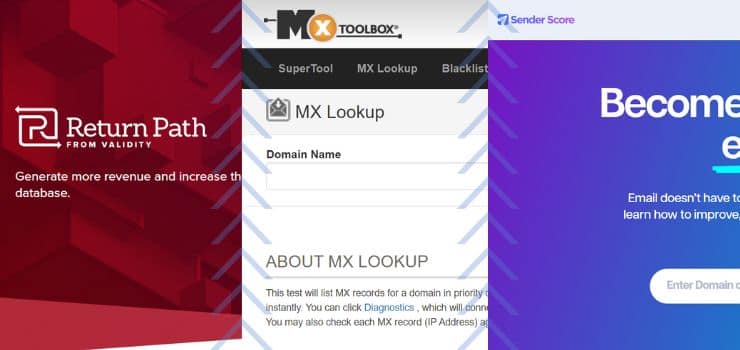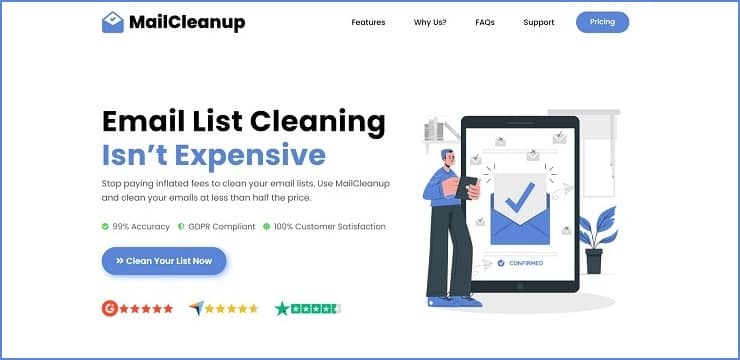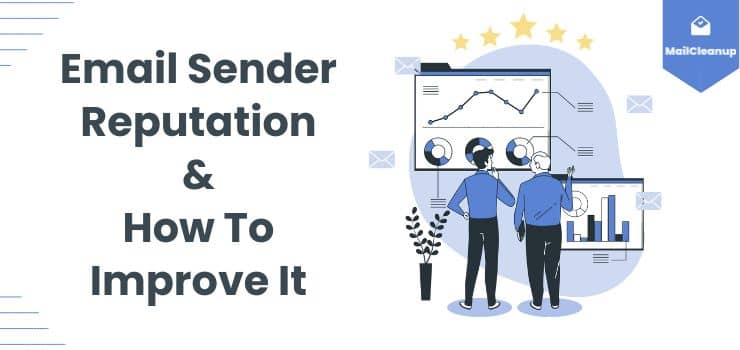As a business owner or marketer, you know that email marketing is a powerful tool for reaching your target audience and driving conversions. But did you know that your email sender reputation plays a crucial role in the success of your email campaigns?
Your sender reputation is a score that emails service providers (ESPs) use to determine whether your emails should be delivered to recipients’ inboxes, spam folders, or blocked altogether.
A poor sender reputation can harm your email deliverability and damage your brand’s credibility.
In this article, we’ll explore why your email sender reputation matters and provide you with practical tips on how to boost it.
By implementing these strategies, you’ll be able to improve your email deliverability, increase your open and click-through rates, and ultimately, achieve better results from your email marketing efforts.
So, let’s dive in!
What is Sender Reputation?
Email sender reputation is a score that Email Service Providers (ESPs) use to determine whether your emails should be delivered to recipients’ inboxes, spam folders, or blocked altogether.
This score is based on various factors, including your email engagement rates, complaint rates, spam trap hits, and more. Your sender reputation can be thought of as your email marketing “credit score.”
Just as a low credit score can make it difficult to get approved for loans or credit cards, a poor sender reputation can make it hard to get your emails delivered to your subscriber’s inboxes.
Why is Email Sender Reputation Important?
Your email sender reputation is important because it directly affects your email deliverability. If your sender reputation is poor, your emails are more likely to be filtered into spam folders or blocked altogether. This means that your subscribers may never see your emails, and you’ll miss out on potential conversions.
Additionally, a poor sender reputation can damage your brand’s credibility. If your subscribers are receiving spammy or irrelevant emails from your brand, they’re likely to view you in a negative light and may even unsubscribe from your list.
On the other hand, if you have a good sender reputation, your emails are more likely to reach your subscriber’s inboxes, and you’ll be able to build trust and credibility with your audience.
How is Email Sender Reputation Measured?
Email sender reputation is measured using a variety of factors, including:
1. Email Engagement Rates
Email engagement rates refer to how frequently your subscribers open, click, and interact with your emails. High engagement rates are a positive signal to ESPs that your emails are relevant and valuable to your subscribers.
2. Complaint Rates
Complaint rates refer to how many of your subscribers mark your emails as spam or otherwise complain about them. High complaint rates are a negative signal to ESPs that your emails are unwanted or unsolicited. On average, the maximum complaint rate is 0.15%. So, if your complaint rate for any email campaign is >(or =)0.15% then you are more likely to get blocked.
3. Spam Trap Hits
Spam traps are email addresses that are specifically designed to catch spammers. If you’re sending emails to these addresses, it’s a sign to ESPs that you’re not following best practices and may be sending spam.
4. Bounce Rates
Bounce rates refer to how many of your emails are returned as undeliverable. High bounce rates can be a sign that your email list is outdated or contains invalid email addresses.
5. Blacklistings
If your IP address or domain is added to a blacklist, it’s a sign to ESPs that you may be sending spam or engaging in other malicious activities.
These factors are used to calculate your sender reputation score, which can range from 0 to 100. The higher your score, the better your sender reputation.
Factors that Affect Email Sender Reputation
There are several factors that can affect your email sender reputation, including:
1. Email Content
The content of your emails can have a significant impact on your sender reputation. If your emails contain spammy or misleading content, they’re more likely to be marked as spam, which can harm your sender reputation.
2. Email List Quality
The quality of your email list is also important for maintaining a good sender reputation. If your list contains invalid email addresses or spam traps, it can harm your sender reputation. To remove such invalid or expired email addresses, you can use MailCleanup.
MailCleanup is a robust email verification service that offers up to 99% accuracy. Our service employs several email verification measures to remove all the bad email addresses from your email list. This ultimately will help you improve your email list quality.
3. Email Frequency
Sending too many emails, or sending emails too frequently, can also harm your sender’s reputation. If your subscribers receive too many emails from you, they may start marking them as spam or unsubscribing from your list.
4. Sending Domain and IP Address
Your sending domain and IP address can also affect your sender reputation. If your domain or IP address has a history of sending spam or engaging in other malicious activities, it can harm your sender reputation.
5. Email Authentication
Proper email authentication, including DKIM, SPF, and DMARC, is important for maintaining a good sender reputation. Without these protocols in place, your emails may be more likely to be marked as spam or spoofed.
How to Improve Your Email Sender Reputation
Now that we’ve covered why your email sender reputation matters and what factors can affect it, let’s dive into some practical tips for improving your sender reputation:
1. Clean Up Your Email List
One of the most important things you can do to improve your sender reputation is to clean up your email list. Remove invalid email addresses, suppress inactive subscribers, and remove any email addresses that have marked your emails as spam.
You can use professional list cleaning software like MailCleanup that provides the best list verification service with accurate results. One of the best characteristics of MailCleanup is that it is the cheapest service available in the market.
Apart from this, we highly rate ZeroBounce for its email verification service. But then again, it is significantly more expensive than MailCleanup.
2. Segment Your Email List
Segmenting your email list can also help improve your sender reputation. By sending targeted, relevant emails to specific segments of your list, you’ll be more likely to see high engagement and low complaint rates.
3. Send Relevant and Valuable Content
Sending relevant and valuable content to your subscribers is key to maintaining a good sender reputation. Ensure your emails are personalized and targeted to your subscribers’ interests and needs.
4. Monitor Your Email Engagement Rates
Keep an eye on your email engagement rates and make adjustments as needed. If you see low engagement rates, try changing your email content or frequency to see if that improves your engagement.
5. Implement Email Authentication
Proper email authentication, including DKIM, SPF, and DMARC, is important for maintaining a good sender reputation. Make sure these protocols are properly set up for your domain and that your emails are passing these authentication checks.
6. Use a Dedicated IP Address
Using a dedicated IP address can also help improve your sender reputation. With a dedicated IP address, you’ll have more control over your sending reputation and won’t be affected by other senders on a shared IP address.
Best Practices for Maintaining a Good Email Sender Reputation
In addition to the tips we’ve already covered, here are some best practices for maintaining a good email sender reputation:
1. Follow Email Marketing Best Practices
Following email marketing best practices, including sending relevant content, honoring unsubscribe requests, and avoiding spammy tactics, is key to maintaining a good sender reputation.
2. Monitor Your Email Deliverability
Keep an eye on your email deliverability and take action if you notice any issues. If your emails are being filtered into spam folders or blocked altogether, it may be a sign that you need to improve your sender reputation.
3. Test Your Emails
Before sending your emails to your entire list, test them to make sure they’re rendering properly and that all links are working. This can help improve engagement rates and avoid complaints.
4. Monitor Your Sender Score
Keep an eye on your sender score and take action if it starts to drop. If you notice any issues with your sender score, investigate the cause and take steps to address it.
5. Use a Reputable Email Service Provider
Using a reputable email service provider can also help improve your sender reputation. Look for an ESP that has a good track record for email deliverability and sender reputation.
Tools for Monitoring Email Sender Reputation
There are several tools available for monitoring your email sender reputation, including:

1. Sender Score
Sender Score is a free tool from Return Path that provides you with a score from 0 to 100 based on your sending practices and inbox placement rates.
2. Mail Tester
Mail Tester is a free tool that allows you to test your emails for spamminess and other issues that could harm your sender reputation.
3. MxToolbox
MxToolbox is a free tool that allows you to check if your domain or IP address is on any email blacklists.
4. Google Postmaster Tools
Google Postmaster Tools is a free tool that provides you with data and insights on your email deliverability, including sender reputation and spam rate.
How to Recover from a Bad Email Sender Reputation
If you’ve already damaged your email sender reputation, don’t worry – there are steps you can take to recover:
1. Identify the Cause
First, identify the cause of your poor sender reputation. Is it due to high complaint rates or Spam trap hits? Once you know the cause, you can take steps to address it.
2. Clean Up Your Email List
Again, it is of utmost importance to clean up your email list by removing invalid email addresses, suppressing inactive subscribers, and removing any email addresses that have marked your emails as spam.

To make things easier for you and also for better results, you can use MailCleanup, which offers the best list cleaning service at a suitable price.
3. Improve Your Email Content
Improve your email content by sending relevant and valuable emails to your subscribers. Avoid spammy tactics and focus on providing value to your audience.
4. Implement Email Authentication
Make sure your emails are passing authentication checks by properly implementing DKIM, SPF, and DMARC.
5. Use a Reputable Email Service Provider
Consider using a reputable email service provider with a good track record for email deliverability and sender reputation.
Conclusion and Next Steps
We hope that you now know what is sender reputation and also understood why it matters.
By following the tips and best practices outlined in this article, you can improve your sender reputation and achieve better results from your email marketing efforts.
Remember to clean up your email list, send relevant and valuable content, and monitor your email engagement rates and sender score.
By taking these steps, you’ll be well on your way to boosting your email sender reputation and achieving email marketing success.
Lastly, here are a couple of other relevant blog posts that you may like –
